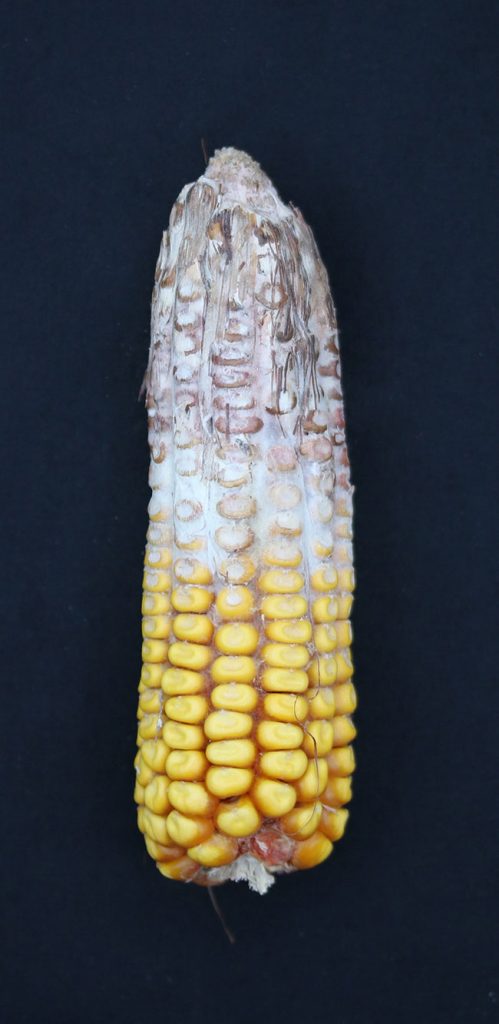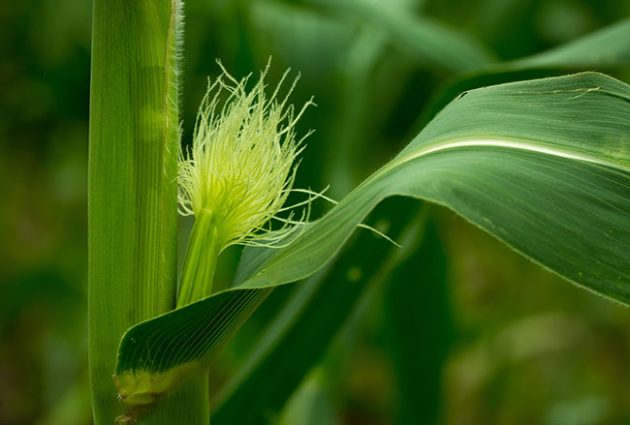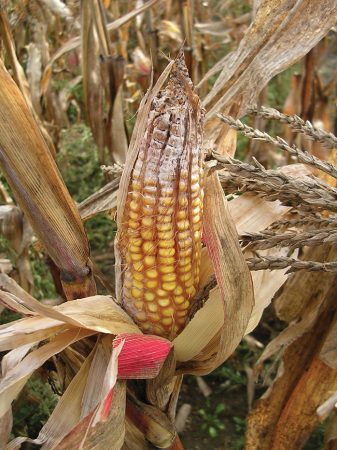
Features
Corn
Diseases
Harnessing the power of corn silk microbes
Fascinating discoveries could help in the fight against Fusarium and other corn threats.
May 15, 2022 By Carolyn King
 Fusarium graminearum-infected corn cob.
photo courtesy of Michelle Thompson, University of Guelph.
Fusarium graminearum-infected corn cob.
photo courtesy of Michelle Thompson, University of Guelph. University of Guelph researchers have discovered that corn silk has an amazingly diverse and dynamic microbial community. This microbiome includes bacteria that may be the plant’s vanguard in its fight against pathogens, pests and other problems that could impact kernel development.
And some of those bacteria could become valuable tools to help corn growers battle such yield-robbers.
“We are very excited about this research and the many new possibilities it is opening up. Before this research, no one knew that there is a tremendous microbial ecosystem in and on corn silks,” says Manish Raizada, whose research group in the University of Guelph’s department of plant agriculture made this discovery.
Much of his group’s work focuses on beneficial endophytes – microbes that live inside plants. Their silk microbiome research sprang from their drive to find endophytes that can help farmers combat Fusarium graminearum. This fungus and its sexual stage, Gibberella zeae, cause devastating diseases including Fusarium head blight in wheat and Gibberella ear rot in corn. These diseases not only reduce grain yield and quality but can also produce toxins like deoxynivalenol (DON) that limit the end-uses of the grain.
“Some years ago, we tested endophytes from different corn tissues, especially seeds, for their activity against Fusarium. We tested the most successful ones by spraying them on corn silks and had some success with that,” Raizada notes. They targeted the silks in these field tests because the silks are the pathway that Fusarium uses to reach the developing kernels.
“That’s when it finally occurred to me that natural selection should favour a silk microbiome with microbes that protect the silks from invading pathogens and pests.” So, Raizada and his research group launched their silk microbiome project to test this hypothesis.
Exploring the silk microbiome
“Each corn cob has up to about a thousand ovules that are potential kernels. Each of these ovules produces a strand of corn silk that eventually emerges from the end of the ear,” explains Eman Khalaf, a post-doctoral researcher who has been a member of Raizada’s research group since 2014.
“Pollen grains containing sperm land on the silk threads, which are the female reproductive tracts of corn. The pollen grains use the silk threads as an expressway to deliver sperm to the eggs inside the ovules. If this happens, it means successful fertilization of the eggs and formation of kernels.”
Khalaf notes that the silk microbiome project has two main goals. “The first goal, which is my job, is to explore the composition and diversity of the silk microbiome. We were the first researchers to do that and also the first to study the dynamics of the silk microbiome in response to different stresses, like exposure to Fusarium infection and different weather conditions.” She is the lead author on a recently published scientific paper reporting on this DNA study.
“The second part of the project is based on culturing microbes living inside the silk tissues and characterizing these microbes for their potential biocontrol activity.” Michelle Thompson and Anuja Shrestha, two PhD students in Raizada’s group, are conducting that work.
Other people involved in the DNA study were corn breeder Lana Reid with Agriculture and Agri-Food Canada, researcher Victor Limay-Rios at the university’s Ridgetown Campus, and members of Raizada’s group, including Shrestha, Michael Lynch, Jeffrey Rinne and Charles Shearer.
The first step in the study was to conduct a field trial in 2016 and 2017 at the university’s Ridgetown Campus. The study team grew a set of 14 Canadian corn lines, including 11 inbred lines developed by Reid and three commercial hybrids. All included lines have some resistance to Fusarium.
For each line, half the plants were treated with F. graminearum, and the other half were the control. The fungus was applied to the silks shortly after pollination because that is Fusarium’s entry time.
The DNA was extracted from the pollinated silks, and a section of the DNA known as the 16S gene was sequenced for all the samples. The 16S gene is found in all bacteria, so it is used to determine if a microbe is a bacterium. And differences in the 16S gene can identify a particular bacterium down to the genus level and sometimes the species level.
“That [16S] DNA sequence is a short barcode from the entire genome,” Raizada explains. “We have seen that one barcode can actually reflect multiple species, so we use the term ‘taxa’ for a unique 16S sequence.”
Khalaf performed the computational analysis of these sequences and compared the differences in the silk communities between 2016 and 2017 and between the healthy silks and the Fusarium-treated silks.
Healthy microbiome: Diverse, dynamic
“From this analysis, we can say that the silk microbiome is complex and dynamic. It is complex in that the healthy silk tissues possessed thousands of bacterial species. It is dominated by a limited number of species that were most abundant, which we identified as the core microbiome,” Khalaf says.
“It is dynamic in that the silk microbiome composition changes when exposed to different environmental stresses like Fusarium infection and weather differences from year to year.”
“We were astounded to find that there were at least 5,000 taxa in the healthy silks of this collection of 14 corn genotypes,” Raizada says. “We suspect those 5,000 taxa represent many more than 5,000 species. There are at least 1,300 genera.”
One of the most interesting aspects about the healthy, pollinated silk microbiome is that some of the most abundant bacteria are ones known from other research to be capable of providing benefits to plants, such as protecting against pathogens or insect pests, fixing nitrogen or improving drought tolerance.
The researchers hypothesize that some of these bacteria may be performing these beneficial functions in the silk microbiome, which might explain the remarkable complexity of this microbiome.
Dramatic changes in response to Fusarium
Khalaf’s analysis also showed that the Fusarium treatment led to a dramatic drop in the bacterial diversity of the silk microbiome. However, at the same time, the total population of bacteria in the silks actually doubled because a few species shot up in numbers.
The decrease in diversity was due to the loss of many of the already-rare species in the healthy silk microbiome. Khalaf notes, “These rare taxa give more strength for the microbial community. With the Fusarium infection, we lost part of the genetic repertoire of the microbiome.”
She outlines some of the possible reasons for this diversity loss. The Fusarium fungus may be competing with certain bacterial species in the resident silk microbiome for specific nutrients. Also, toxins secreted by the fungus may be harmful to some of the bacteria. As well, the silk cells’ own defences against Fusarium may be affecting some bacteria.
In contrast, the bacteria that became much more abundant were part of the core microbiome in the healthy silks, so they were already present in high numbers before the Fusarium treatment.
“We think the bacteria that increased in the Fusarium-treated silks are the ones that are protecting against Fusarium. If the pathogen had been different or if there was a different environmental stress such as low nitrogen, then perhaps a different subset of bacteria might have increased in abundance,” Raizada says.
“We hypothesize that natural selection has led to the plant possessing a menu of silk microbes, and then certain microbes are called upon depending on the needs at the time.”
He adds, “A corn silk is one of the fastest growing tissues in nature. That means if there is any type of environmental stress, like drought or insufficient nitrogen, it slows down silk growth. And if the silks cannot emerge out of the cob, there is no tissue to receive the pollen, and you get a total failure of yield.” This might be why the silk microbiome’s menu includes bacteria that are able to enhance drought resistance or fix nitrogen.

Corn silk has a diverse and dynamic microbial community, which includes bacteria that may be the plant’s vanguard in its fight against pathogens, pests and other problems that could impact kernel development, according to Raizada’s research group at the University of Guelph. Photo courtesy of wisawa222/ADOBESTOCK.
Year-to-year differences
“[Khalaf] also discovered quite a lot of variation in the microbiome between 2016 and 2017. Like any two years, there were differences in rainfall and temperature patterns. We also know Fusarium outbreaks vary tremendously from year to year,” Raizada notes.
“Part of the reason for this [outbreak] variation is that the input of Fusarium spores varies because the fungus is affected by temperature and humidity. Our findings suggest we could add another variable to this equation. The year-to-year variations in the silk microbiome might mean that the protection against Fusarium in the silks is also varying from year to year.”
Sprays to fight Fusarium
Their silk microbiome discoveries have opened doors to many other areas of investigation for Raizada’s group. One key area to look into is possibilities for managing Fusarium.
“In parallel to [Khalaf]’s DNA study, Michelle Thompson has cultured more than 1,000 strains of bacteria from the Canadian silks. Michelle has been testing these bacteria for their capacity to kill or suppress Fusarium in lab and greenhouse trials,” Raizada notes.
“Anuja Shrestha is leading another project, which is nearing completion, to examine the diversity of the silk microbiome using corn from across the Americas and across evolution. She collected corn samples all the way from South America to Canada, including modern corn, wild ancestors of modern corn, and ancient farmer landraces from Indigenous people across the Americas, which have been grown in some cases for thousands of years.”
Shrestha has cultured hundreds of the bacterial endophytes extracted from these silks, while Khalaf is conducting the DNA analysis of the silk microbiomes.
Shrestha has also been testing these endophytes against Fusarium in lab and greenhouse trials.
Meanwhile, M.Sc. student Jake Gregory has been testing the silk microbes in field trials in collaboration with Limay-Rios and his team at the Ridgetown Campus.
“We have some promising candidates from the Canadian silks and the silks from across the Americas that are suppressing Fusarium in these trials. This work also supports our hypothesis that the bacteria which increased in response to Fusarium are ones that protect the silks against Fusarium,” Raizada says.
“Many bacteria are not safe for human health or the environment. In all of our work from these studies, we focus on the safest class of bacteria only. So, we are targeting bacteria that actually have commercial, real-world potential.”

Fusarium graminearum and Gibberella zeae cause devastating diseases, including Gibberella ear rot in corn (pictured), which reduce grain yield and quality and produce toxins that limit grain end uses. Photo courtesy of Linda Harris, AAFC.
Breeding to fight Fusarium
“In the next phase of this research, we will be seeking collaborations with breeders to see if we can deliberately select for microbes that suppress Fusarium and particularly if we can breed for a team of microbes that lead to improved resistance,” Raizada explains.
“Over the years, when breeders have been selecting for any trait to suppress a pest or pathogen, it is well known that some of that work is directly selecting for the plant to secrete a natural compound that acts as a fungicide, antibiotic or insecticide.
“However, our working hypothesis is that breeders have also been indirectly selecting for plant genes that promote colonization by certain microbes that are the plant’s secondary defence system. This will be a major direction of my research group as we move forward.”
Other potential benefits
Now that Thompson and Shrestha have cultured all those endophytes, Raizada’s group can also explore other possibilities for practical applications, such as seeing which endophytes could be used for managing insect pests, other pathogens, and drought and/or low-nitrogen conditions.
Some of the most abundant microbes in the silks are bacteria like Rhizobium and Bradyrhizobium, which are known to be capable of fixing nitrogen. “From other plants, we know nitrogen fixation requires a low-oxygen environment and a source of sugar. In legumes, root nodules facilitate both of those, but nitrogen fixation can happen outside of a nodule,” Raizada explains.
Currently, his group is examining what role the nitrogen-fixing bacteria might be playing in the silks. The tests so far show that some of these bacteria can grow in Petri dishes without added nitrogen, indicating that they can fix nitrogen to meet their own needs. The next step will be to determine whether these bacteria fix nitrogen in the silks and, if so, whether that nitrogen just supplies the bacteria’s own needs or if it also benefits the plant.
Raizada is also planning to investigate the silk bacteria that have been reported in other studies to produce insecticidal compounds. He notes the corn earworm larvae crawl down the silk to feed on the kernels, and other corn insects feed on the silks. So, perhaps these bacteria are helping to protect the silks and kernels from such pests.
The main funding sources for these silk microbiome studies include Grain Farmers of Ontario, the Organic Science Cluster, Natural Sciences and Engineering Research Council, the Ontario Ministry of Agriculture, Food and Rural Affairs, and Ontario Genomics.